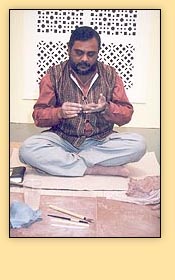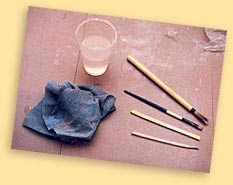|
The Potters Art
 Manabodha Rana (1959 – ) is a master craftsperson from Sambalpur in
Orissa, and specializes in the design and creation of terracotta
roof tiles. Each roof tile is fashioned using a mixture of black
and red clays, and is fired in a kiln which uses leaves and cow dung
as fuel. Featuring figures such as chirping birds, frolicking
monkeys, lizards, turtles, bears, demons and demonesses, tiles
like these are designed to ward off the evil eye, and are an
enchanting sight on the roofs of thatched huts throughout Orissa. In addition to his work in tile, Manabodha Rana also makes votive
figures, as well as many other terracotta items of a functional,
decorative or ritualistic nature. Manabodha Rana (1959 – ) is a master craftsperson from Sambalpur in
Orissa, and specializes in the design and creation of terracotta
roof tiles. Each roof tile is fashioned using a mixture of black
and red clays, and is fired in a kiln which uses leaves and cow dung
as fuel. Featuring figures such as chirping birds, frolicking
monkeys, lizards, turtles, bears, demons and demonesses, tiles
like these are designed to ward off the evil eye, and are an
enchanting sight on the roofs of thatched huts throughout Orissa. In addition to his work in tile, Manabodha Rana also makes votive
figures, as well as many other terracotta items of a functional,
decorative or ritualistic nature.
Making a Clay Figure the Indian Way
The clay
Black clay is taken from a pond; red clay is obtained from farmland.
Mixing and Preparing the Clay
- Stir the clays together in a proportion of two kilograms of red clay
to 1 kilogram of black clay.
- Mix the clays and soak them in water for eight hours.
- Knead the two clays together.
- Set the clay aside for six hours.
 Tools of the Trade Tools of the Trade
- Bamboo modelling tools, made by the artist himself.
- Water and a paintbrush, to smooth the surfont family of the clay.
Fashioning the Clay Figure
- Make the head and torso from a lump of clay. Make little pinches
in the head to create the font family. Roll out four pieces of clay to make
the arms and legs, then attach them to the body.
- Create jewellery and eyes with small bits of clay. Add details
with a modelling tool.
- Apply water with a paintbrush to create a smooth final finish.

How Clay is Fired in India
Terracotta, which is used by most Indian potters, has a low firing
temperature. This means that village artisans can harden their clay
creations in simple firepits which serve as kilns. To begin, a hole
is dug into the ground. The hole is about 15 to 22 cm (6 to 8 inches)
deep, and wide enough to leave at least 15 cm (6 inches) around the
edges of the piece to be fired. Once the hole is made, the following
materials are placed in the centre of the hole, in the order given
below.
Firing materials:
- Wheat husks
- Cow dung
- Wood
- Clay figure or object
The fire is then lit in the 15-cm space around the object, leaving
room for the fire to spread gradually inwards. Firing of clay figures
like this last a total of 12 hours: the fire itself takes about eight
hours to burn down completely, after which the object is left to cool
in the firepit for three or four hours before it can be removed.

|